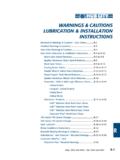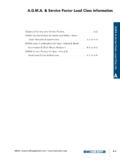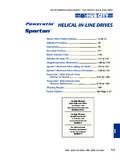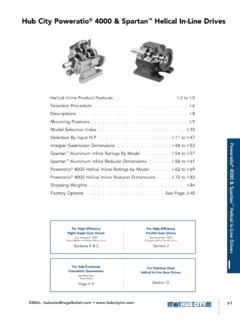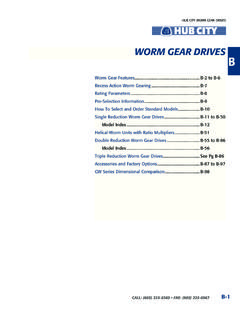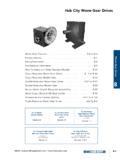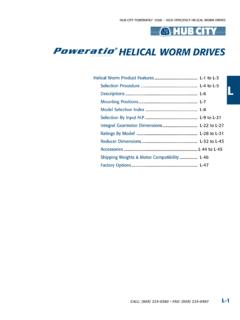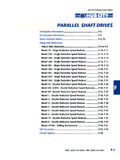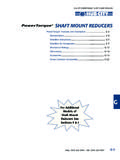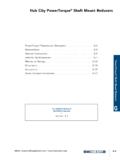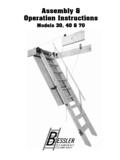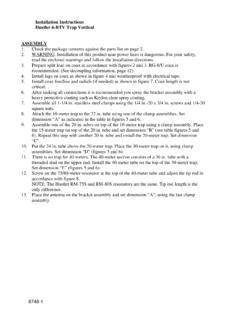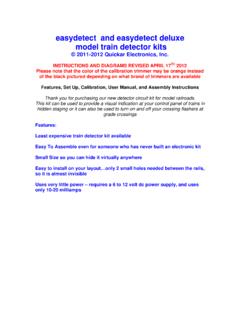Transcription of HUB CITY WORM GEAR DRIVES INSTRUCTIONS …
1 CALL:(605)225-0360 FAX:(605)225-0567 AHUB city worm gear DRIVES INSTRUCTIONST hese general maintenance INSTRUCTIONS cover Series 130 through Series 80 worm gear Reducers. Your reducer may be slightly different than thereducers shown in the figures below, and to the right, but these generalinstructions will still is advisable to periodically inspect your Speed Reducer for any signs ofimpending service. Spare or replacement parts can often be ordered andobtained before disassembly is necessary, thus minimizing machinedown-time. The following symptoms can be inspected visually withoutdisassembly and may, in some cases, indicate extensive LEAKING FROM SEALS indicates that shaft and/or seals are worn andneed replacing. Keep dirt and foreign particles off shafts in the area of theseals to minimize LEAKING FROM INPUT OR OUTPUT CAPS, CAP SCREWS OR PIPEPLUGS might be corrected by retightening or removal and recoating withLoctite or pipe sealant as required before tightening.
2 If this does not correctthe leaking condition, disassembly will be necessary to replace END PLAY OF SHAFTS if there is noticeable shaft movementwhen couplings are removed and shaft is moved back and forth, it may be anindication of bearing wear. Replacement may be BACKLASH would indicate worm gears which might have tobe INTERNAL OPERATING TEMPS (ABOVE 200 F OR 95 C) if a unitexhibits high internal operating temperatures, one or a combination of thefollowing may be the Unit is overloaded, application may require replacement with highercapacity Damaged bearings, components or improper bearing Improper oil level, lubricant type or lubricant High ambient High speed operation in excess of rated the initial factory assembly, Loctite is used on the threads of allcapscrews.
3 If any screws are removed, a new application of Loctite isrequired. NOTE: Screw threads and the threaded hole must be degreasedbefore application of Loctite .For safe operation and to continue the unit warranty, when installing,reinstalling, or replacing a factory installed fastener for servicing purposes, orto accommodate the mounting of guards, shields or other light load imposingdevices, or for mounting the unit, it becomes the responsibility of the customeror user to properly determine the quality, grade of fastener, threadengagement, load carrying capacity, tightening torque, and the means oftorque : SERIES 130 HAS BALL BEARINGS ON OUTPUT2223111282026221919166161211283233 1927187102425145154312542414233310932125 6101471894A36183871333210242514515431 Maintenance InstructionsFigure 1 Typical Output Shaft AssemblyFigure 2 Ball Bearing Input Shaft AssemblyFigure 3 Tapered Bearing Input Shaft AssemblyFigure 4 Motorized Input AssemblyWARNINGM aintenance InstructionsBCALL:(605)225-0360 FAX:(605)225-0567 The figures on page B-128 represent a general design configuration for HubCity Century Series worm gear Speed Reducers.
4 There are design differ-ences from model to model, and a general outline of the basic construction isoffered here for clarification and future reference:INPUT SHAFT ASSEMBLY STYLESM otorized VersionsSeries 130-380 Single ball bearing construction opposite motor end asshown in Figure 450-520 Double tapered bearing arrangement opposite motorend, not shownSeries 60-80N/AShaft Input VersionsSeries 130-260 Ball bearing construction as shown in Figure 2. No openinput 320-70 Direct mounted tapered bearings, straddle mounted onworm, and open input cap used as shown in Figure 80 Double tapered bearing arrangement opposite shaftextension, with single spherical roller bearing on shaftextension side. (Not shown)Housing ConstructionSeries 130-260 Have 56C/143TC flange cast integral with housing.
5 Allother input flanges and all other models utilize 130 Utilizes an expansion plug instead of high speed cover(Ref. #4)OUTPUT SHAFT ASSEMBLY STYLESAll series, with the exception of the Series 130, use a straddle mountedtapered bearing design as shown in Figure 1 on both shaft and hollow boreoutputs. Series 130 uses ball 450, 520, 60, and 70 hollow shaft units have flanged output 60, 70, and 80 have shouldered solid output PROCEDUREThe exterior threaded holes on this drive are for mounting the drive or driveaccessories (couplings, sprockets, etc.). They are not to be used for lifting thedrive or any driver/driven certain that the power supply is disconnected before attempting toservice or install the unit, or remove any components. Lock out the powersupply, and tag it to prevent unexpected application of to the figures on page B-128 for the discussion on assembly anddisassembly Disconnect reducer from drive motor, couplings, or driven shafts to guardagainst personal injury.
6 Remove all sprockets or sheaves from reducershafts with a puller tool to prevent accidental damage to Remove Pipe Plug from bottom of gear Case and drain all lubricant , housings, and other components can reach high temperatures duringoperation, and can cause severe burns. Use extreme care when removinglubrication plugs and vents while servicing the protective clothing and eye shields when installing or maintaining unitand If old seals are to be salvaged, cover keyways with cellophane tape,plastic shim stock, or paper before sliding seals over keyway. Remove capscrews from Output Shaft Caps (2) and CAREFULLY remove output shaftassembly. Be careful to keep bearings clean andnot to damage worm gear (8) Remove cap screws from closed input cap (4)and open input cap if applicable.
7 Series 60, 70,and 80 may have fan shroud in place of cap. Usesame procedure. Series 130 requires removal ofexpansion plug. The expansion plug is a nonsalvageable part. CAREFULLY remove inputshaft assembly. On motorized units, removeentire quill assembly from the back of the shaft input units, remove input seal (18) oropen cap if applicable and snap ring (27) if usedand press worm shaft out through front bearing(9). NOTE: Some series allow removal of inputshaft assembly without removal of front sealthrough closed cap end. On Series 80, removebearing locknut, lock washer, and flat input shaft out of housing and Examine Seals (13) for wear or damage and remove from caps or housingonly if replacement is necessary. (When servicing units, seals shouldalways be replaced.)
8 When removed from caps or housing, seals shouldnot be Remove Bearing Cups (11) from output caps and input caps whenapplicable with a puller tool. If driven out, gently tap opposite sides of thebearing cups with a flat punch so they are removed evenly and no damageoccurs to To remove worm gear (8) and Bearing Cone (12) from Output Shaft (6),rest one side of gear on blocks and press shaft through gear and onebearing cone as shown in Figure not attempt to strip the gear and both bearing cones off the output shaft inone operation. The Key (17) will lodge against Bearing Cone (12) and severedamage will 450, 520, 60 and 70 units have flanged output sleeves on the shaftmount models. To remove the worm gear from these models, the sleeve mustbe pressed out so gear moves away from the flange.
9 The back side of theflange is recessed to allow a puller to be used to remove the bearing conefrom the short end of the output 60, 70, and 80 have shouldered output shaft. To remove gearassembly, press on shaft so gear assembly moves away from If input shaft bearings are to be reused, use bearing puller tool or properbearing removal fixture so no damage occurs to PROCEDURE1. All parts, including the gear case, should be cleaned thoroughly with anapproved, non-flammable, nontoxic solvent. Any accumulation of sludgedeposits or corrosion should be removed. Whenever input or output capsare removed, it is recommended that seals and shims be replaced. Theseand other miscellaneous items are included in each Reducer Repair reassembly, examine input and output shafts for grooving in theshaft seal area.
10 If the shafts are to be reused, polish out any imperfectionswith a fine grade of emery cloth. The polishing motion should becircumferential, not axial or spiral in direction. Shaft grooving .010 deep orgreater cannot be corrected by polishing. These shafts should be replacedor the seal installed in a new axial location to allow contact in non groovedareas. Some units do not allow space for repositioning of the city worm gear DRIVES INSTRUCTIONSFIGURE 5 Removal ofWorm gear and Bearing ConeWARNINGCAUTIONCAUTIONWARNINGWARNINGC ALL:(605)225-0360 FAX:(605)225-0567 CHUB city worm gear DRIVES INSTRUCTIONSM aintenance Instructions2. Replace Bearing Cups (14) in output caps and input caps when applicablebeing careful to remove any foreign particles in the counterbore. Bearingcup must seat squarely in counterbore of cap.
